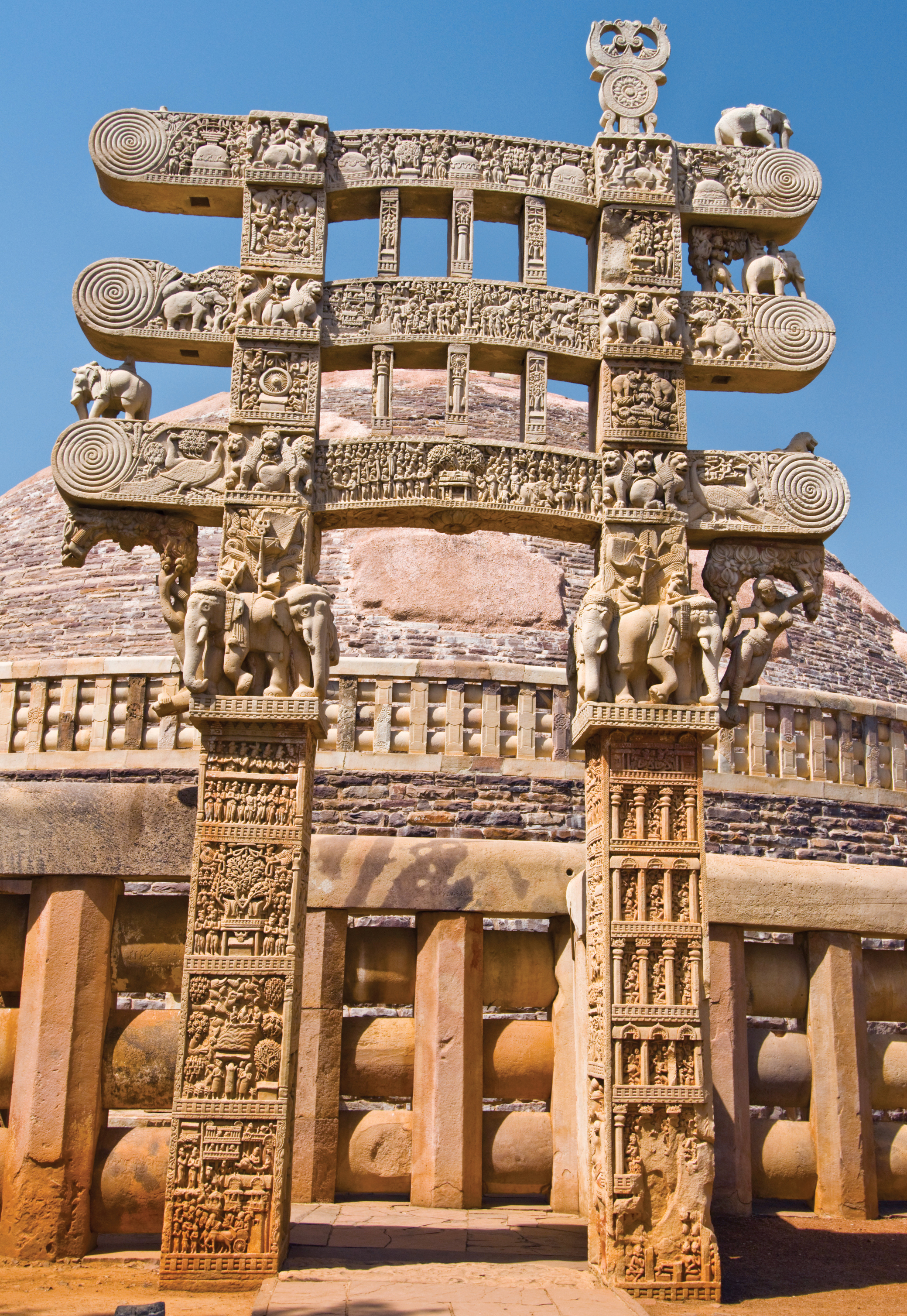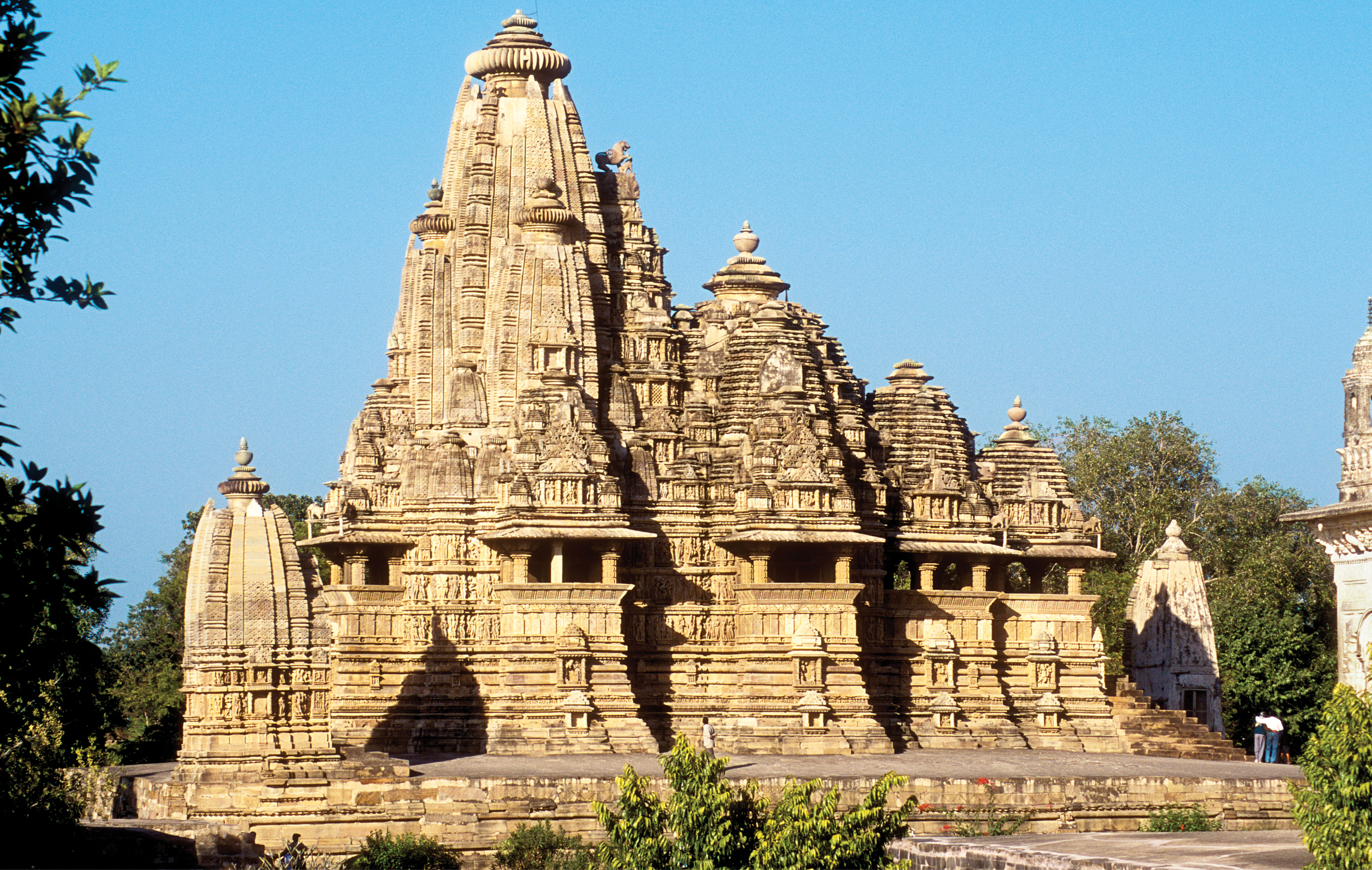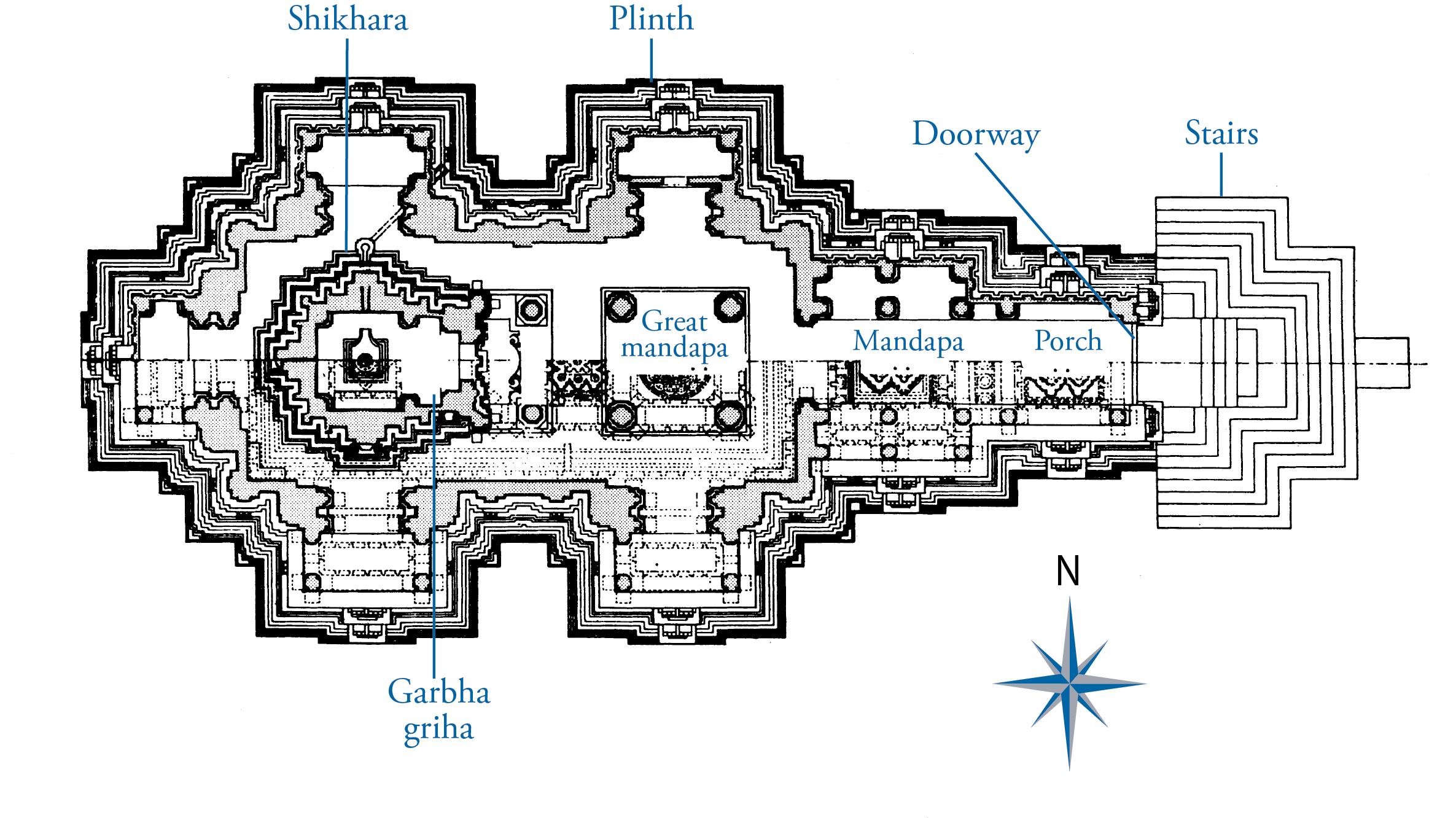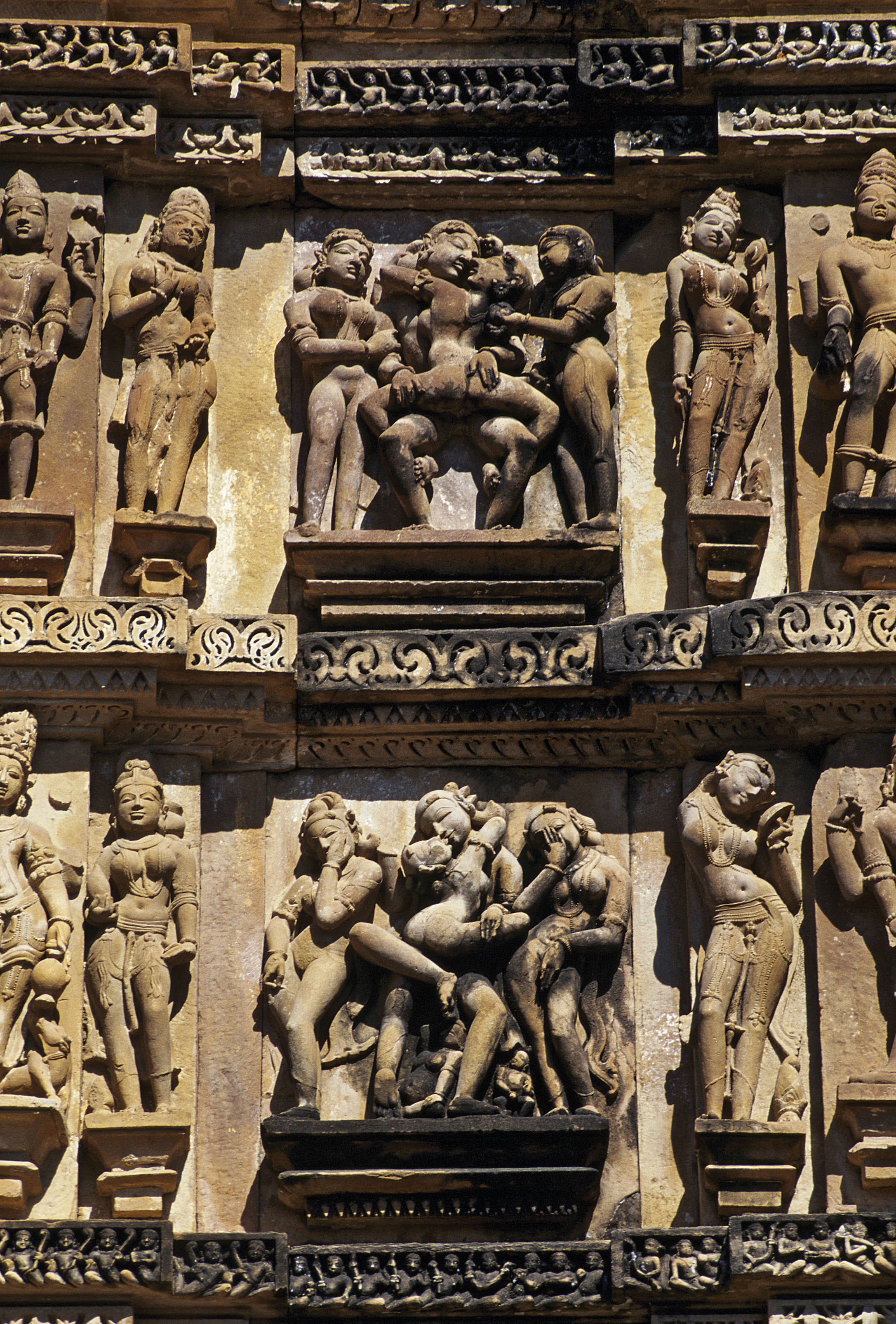India, Pakistan, Southeast Asia | Study Guide Images
View the study guide images for this region. You can access each study guide image and its information by clicking on the corresponding tab. Feel free to rearrange the tabs by clicking and dragging them over one another. Click on the menu icon to reset the accordion. Hovering over the menu icon allows you to navigate to a study guide image you wish to see.
Robed Male Figure
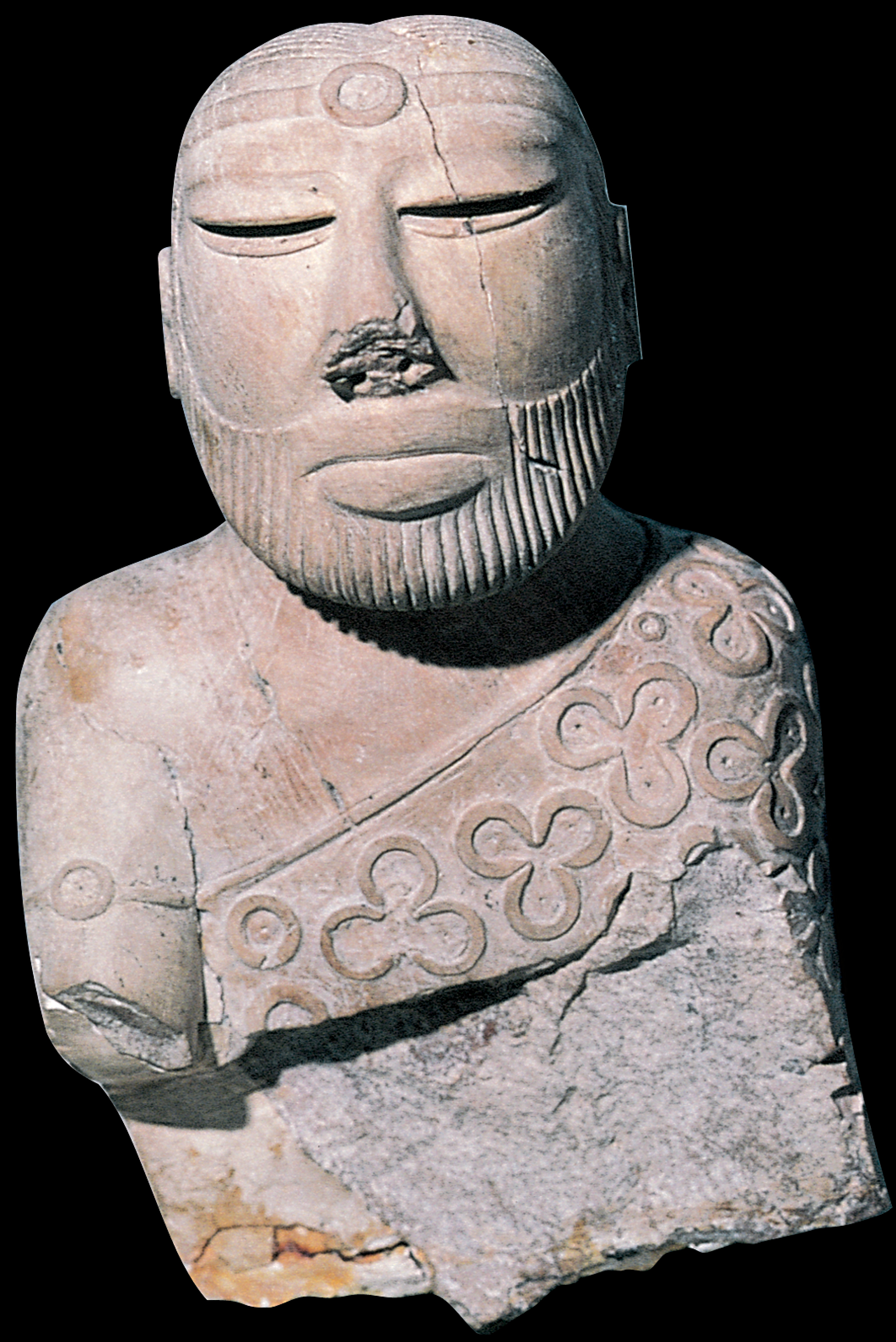
Robed Male Figure: less than 7 inches tall
found in Mohenjo-daro, Pakistan
Indus Valley Civilization
2600 - 1500 BCE
Your eBook, Kleiner Art Through the Ages, 15th edition, describes the image as follows. "The most impressive preserved sculpture is the "Robed Male Figure" which is less than 7 inches tall. Made of steatite (soap stone), this sculpture can be described as a robed male figure with half-closed eyes, a low forehead, and a closely trimmed beard with shaved upper lip. He wears a headband with a central circular emblem, matched by a similar armband. Trefoils are clover-like designs with three stylized leaves that decorate his elegant robe. The circles, eyes and the trefoils originally held red paste and shell inlays. The trefoil motif suggests that this is of a priest-king when compared to the Sumerian sculptures. The elaborate costume and precious materials make it clear that this is the statuette of an elite individual."
This tiny object is one of only a few remains of the art of the Indus Valley Civilization, a once flourishing culture that existed along the Indus River Valley between modern India and Pakistan.
Form
The representation, in stone, of what we may determine was an elite member of society. What are some of the features of dress that would suggest this social status? Frontal figure.
Style
The human figure, presumably male, is stylized in ways that suggest one the one hand a connection
to other contemporary flourishing civilizations and cultures in the region of the eastern Mediterranean, such as Egypt,
and the areas of the Tigris and Euphrates river valley ancient Mesopotamia, with whom these peoples traded. For example,
statuettes of worshippers from Sumer (Iraq) illustrated in Chapter 2. Compare the statuette of the male worshipper
with the male figure from Mohenjo-Daro. What similarities do you see: Pose? Treatment of the hair? Costume? Facial
features?
On the other hand, what aspects of the Mohenjo-daro male figure do not seem like those from Mesopotamia?
Meaning
Unconfirmed, but the assumption is that this is a male personage of importance to the community: a leader, ruler, priest, deity?
Context
Familiarize yourself with the social and cultural aspects of the Indus Valley Civilization.
What other types of
remains, including art, are also found there and how do they relate to this small sculpture?
Lion Capital
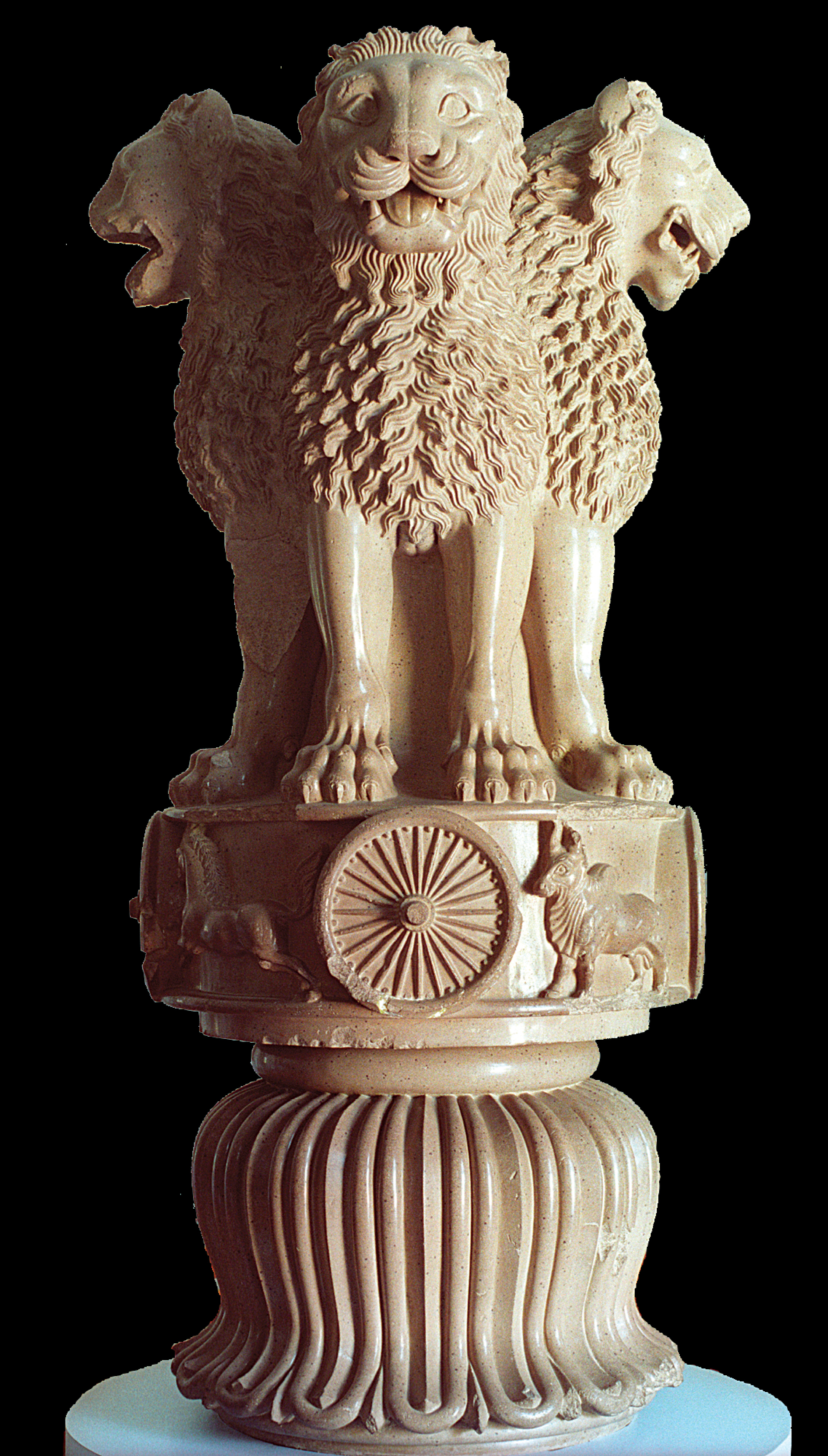
Lion Capital: polished sandstone, 7 feet high
found in Sarnath, India
Maurya Dynasty
323 - 185 BCE
Your eBook, Kleiner Art Through the Ages, 15th edition, describes the image as follows. "At seven feet high, the Sarnath capital and a contemporaneous statue representing a fertility goddess found near the Mauryan capital are among the earliest works of life-size sculpture in South Asia. Stylistically, the capital owes much to ancient Mesopotamia and Persia, especially the Achaemenid art of Persepolis, but, like that of the Lauriya Nandangarh pillar, its iconography is Buddhist."
This powerful representation of the Buddhist faith is one of the first examples of Buddhist art in India.
Form
Basically, it is a capital of a free-standing column (pillar); an architectural member that functioned as a weight-bearing support for something heavy, or as a decorative finial. In what ways is the function of stability maintained by the form?
Style
The lions are stylized. In what ways are the forms of nature arranged to create uniformity? What aspects of the lion are emphasized?
Meaning
There are several levels of meaning: religious, and political. Can you, in reading about King Ashoka’s kingdom, suggest how this capital represents both? Are there any more?
Context
Here, again, what historical and religious developments of the Maurya Dynasty explain why this was created? Why is this period called aniconic?
Yakshi, E. Gateway, Great Stupa
Yakshi, detail of bracket: sandstone, 5 feet high
East Gateway: sandstone, 34 feet high
Great Stupa: 50 foot tall earth-and-rubble domical mound
found in Sanchi, India
Andhra Dynasty
185 BCE - 320 CE
Your eBook, Kleiner Art Through the Ages, 15th edition, describes the image as follows. "Carved on the east torana of the Great Stupa and serving as a bracket linking the lowest architrave with piers is a yakshi. These sensuous, nearly nude goddesses were worshiped throughout India. They personify fertility and vegetation and were long-established statuary types in the repertoire of South Asian sculptors. The Sanchi yakshi reaches up to hold a mango tree branch while pressing her left foot against the trunk, which causes the tree to flower."
This is a small detail from a large Buddhist monument: the Great Stupa of Sanchi.
Form
High relief sculpture, part of three-dimensional figures that embellish the four gateways to the stupa.
Style
Idealized naturalism.
Meaning
Iconography – complex, multi-layered meaning. What is a yakshi? Why is she dressed (or undressed) like this. What is she doing with the tree? What is her relationship to Buddhism?
Context
What is a stupa? How does it relate to Buddhism?
Meditating Buddha
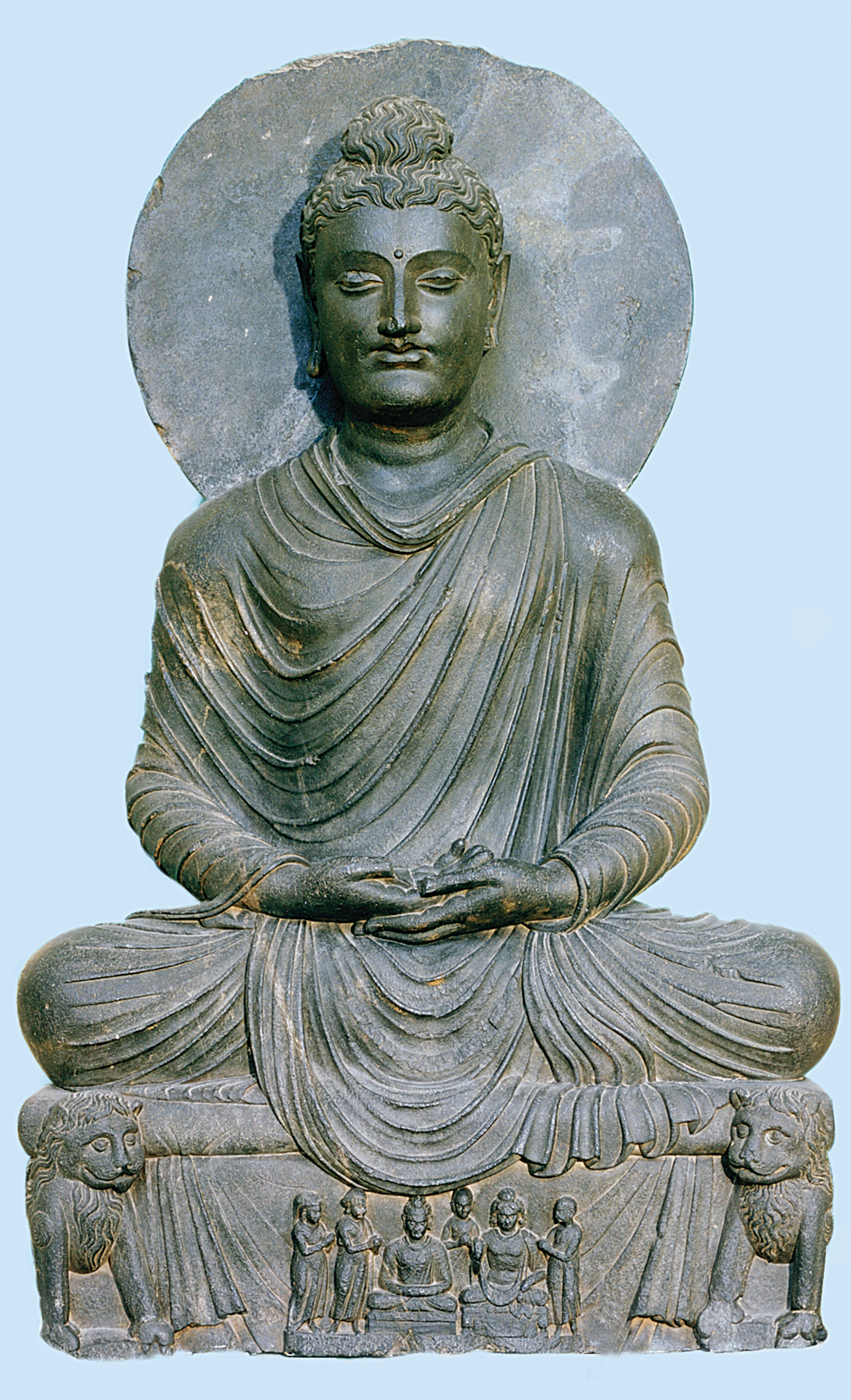
Meditating Buddha: gray schist, 3 feet 7 inches high
found in Gandhara, Pakistan
Kushan Dynasty
Your eBook, Kleiner Art Through the Ages, 15th edition, describes the image as follows. "A second-century ce statue carved in gray schist, the local stone, shows the Buddha, with halo, ushnisha, and urna, dressed in a monk’s robe, seated in a cross-legged yogic posture similar to that of the male figure with a horned headdress on the Indus seal. The Buddha’s hands overlap, palms upward, in the dhyana mudra, the gesture of meditation (see “ Buddhist Iconography”)."
This is one of the earliest representations of the historical Buddha in human form.
Form
The Buddha represented as seated in a yogic posture, possibly in meditation. This form becomes standardized throughout Buddhist art history. Deep relief sculpture.
Style
Gandharan Style. This is a regional style from Northwest India and Pakistan, often identified as a hybrid style derived from Greek and Roman art of the 1st-2nd century AD. For examples see representations of Apollo and Roman Emperors in Chapters 5 and 7. What is the other style of Buddhist art being practiced in the realms occupied by the Kushan Dynasty? How do these two different styles compare?
Meaning
Iconography: Standardized poses and embellishments (lakshana) to suggest a superhuman person: mudra, halo, elongated earlobes, expanded cranium, and to recall traditionally remembered events, both human, and superhuman, from the Buddha’s biography.
Context
The occupation of northern India and Pakistan by powerful tribes known as the Kushans who espoused Buddhism and produced the first images in human, iconic, form.
Seated Buddha Preaching

Seated Buddha Preaching: tan sandstone, 5 foot 3 inches high
found in Sarnath, India
Gupta Dynasty
320 - 647 CE
Your eBook, Kleiner Art Through the Ages, 15th edition, describes the image as follows. "Under the Guptas, artists formulated what became the canonical image of the Buddha, combining the Gandharan monastic robe covering both shoulders with the soft, full-bodied Buddha figures with clinging garments of Mathuran sculpture. These disparate styles beautifully merge in a fifth-century statue of the Buddha from Sarnath. The statue’s smooth, unadorned surfaces conform to the Indian notion of perfect body form and emphasize the figure’s spirituality. The Buddha’s eyes are downcast in meditation, and he holds his hands in front of his body in the Wheel-turning gesture, preaching his first sermon. Below the Buddha is a scene with the Wheel of the Law at the center between two (now partially broken) deer symbolizing the Deer Park at Sarnath."
The high point of Indian Buddhist sculpture.
Form
Now standard icon of the seated Buddha. Deep relief sculpture.
Style
“Gupta Style.” Prescribed by artistic canons. Idealized naturalism; representations of human forms derived from perfect non-human forms in nature. Compare the style with both the earlier Gandharan and Mathuran styles of Buddhist art under the Kushan Dynasty. What similarities and differences do you notice?
Meaning
Iconography: an event from the biography (life) of the Buddha. Discuss all the visible features that indicate the figure as the Buddha, and that remind us of his teachings.
Context
Read about the cultural accomplishments of the Gupta Dynasty and its geographical reach.
Bodhisattva Padmapani
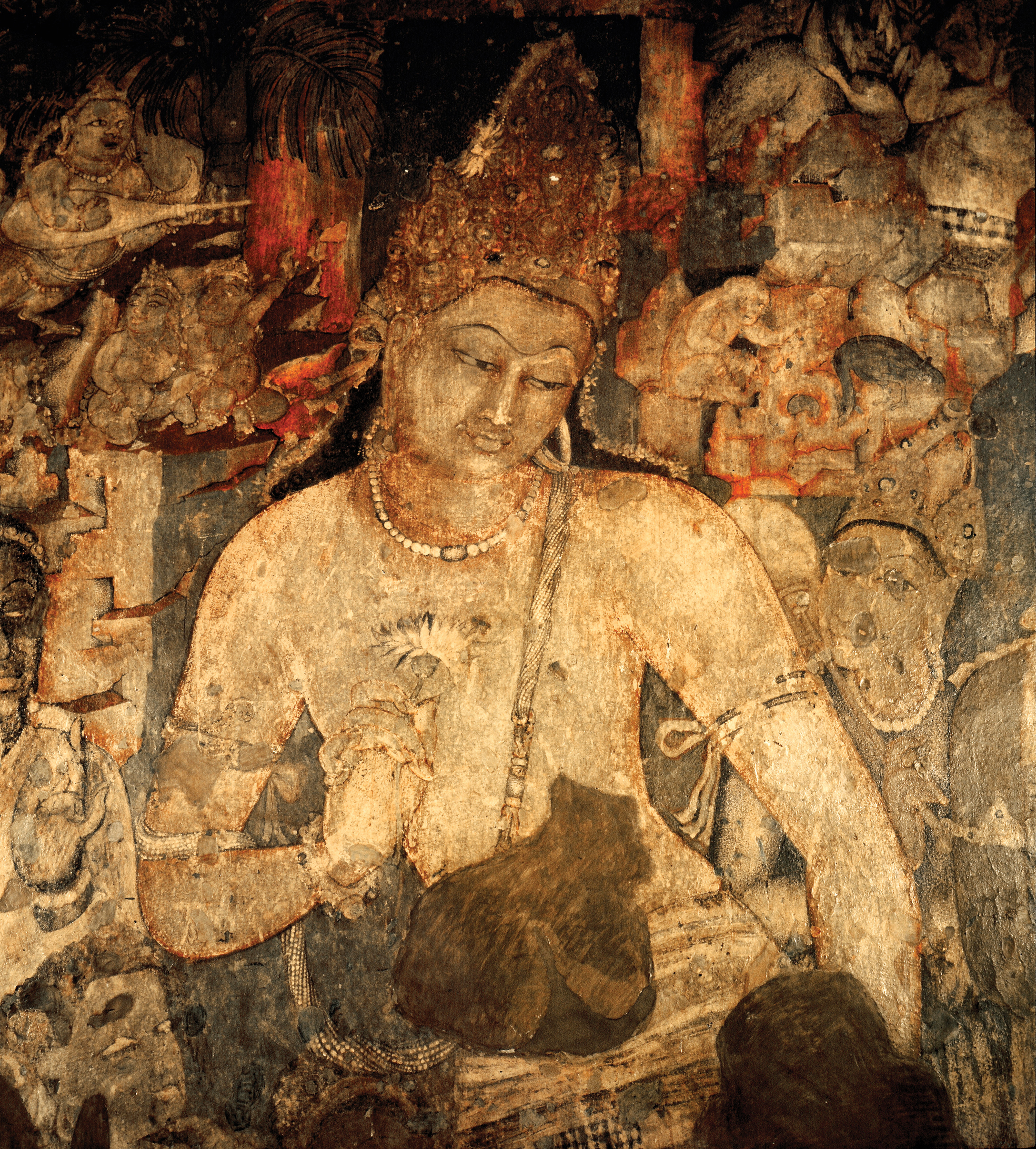
Bodhisattva Padmapani: detail of a wall painting in the antechamber of cave 1
found in Ajanta, India
Gupta Dynasty
320 - 647 CE
Your eBook, Kleiner Art Through the Ages, 15th edition, describes the image as follows. "At Ajanta in the Deccan region, paintings cover the walls, pillars, and ceilings of several caves datable to the second half of the fifth century. The detail reproduced here comes from one of the restored murals in cave 1 at Ajanta. The bodhisattva Padmapani sits among a crowd of musicians, monkeys, and devotees, both princes and commoners. With long, dark hair hanging down below a jeweled crown, he stands holding his attribute, a blue lotus flower, in his right hand. The painter rendered with finesse the sensuous form of the richly attired bodhisattva, gently modeling the figure with gradations of color and delicate highlights and shading, especially evident in the face and neck. The artist also carefully considered the placement of the painting in the cave, putting it on the left wall of the entrance to the antechamber of the main shrine. From that location, the bodhisattva gazes downward at worshipers entering the antechamber on their way to the rock-cut Buddha image in a cell at the back of the cave."
The high point of Indian Buddhist painting.
Form
Large-scale mural executed in “dry fresco.” On wall of Buddhist caves.
Style
“Gupta Style.” The medium allows for suggesting 3-dimensional forms through the use of highlighting and shading (modeling). Elegant movements and gestures of figures suggest those of Indian dance.
Meaning
Who/what is a Bodhisattva? How is a Bodhisattva distinguished from a Buddha? Costume, gestures?
Context
What is the significance of the site of Ajanta?
Shiva as Mahadeva
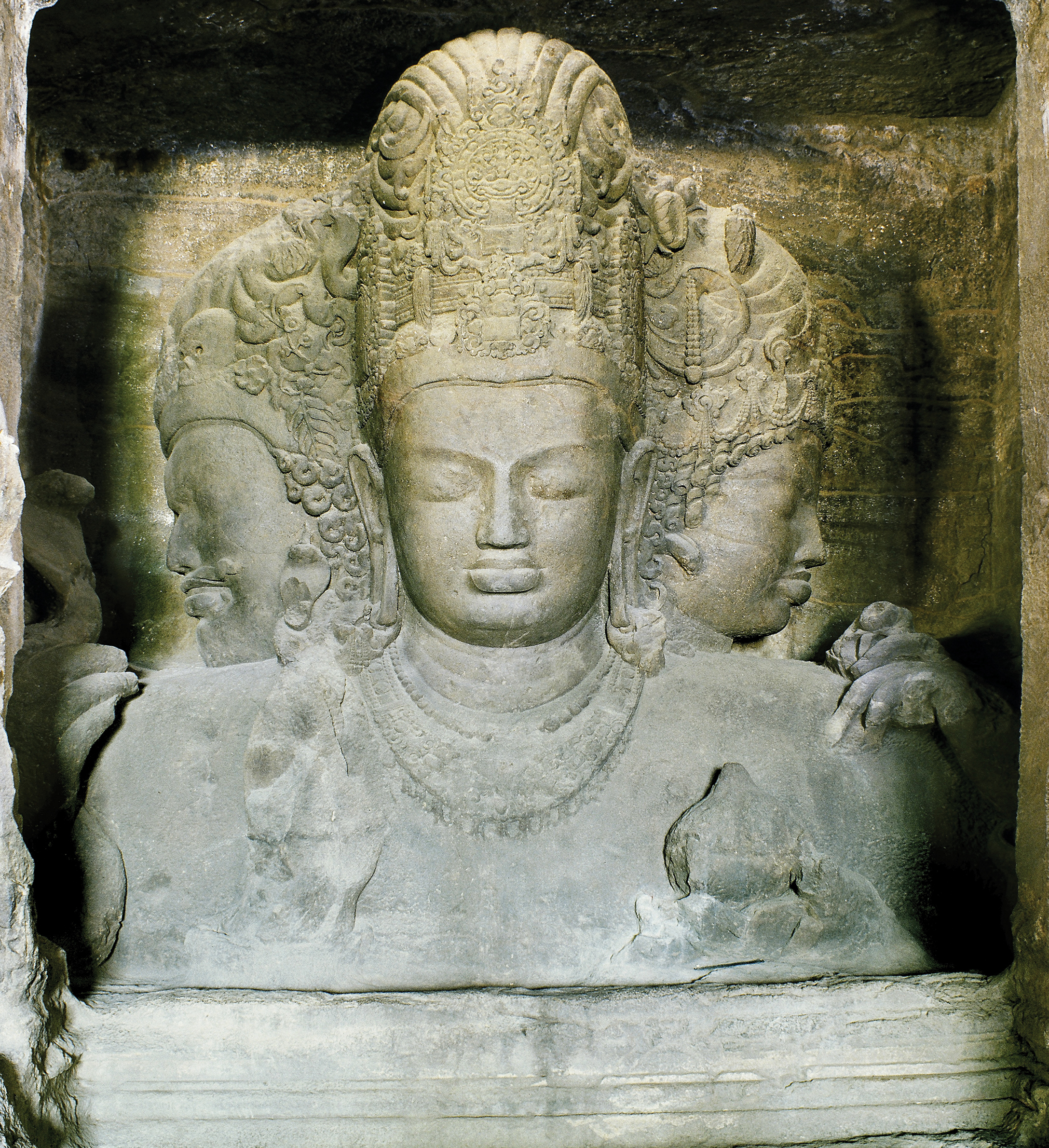
Shiva as Mahadeva: basalt, Shiva, 17 feet 10 inches high
found in Elephanta, India
Kalachuri Dynasty
320 - 647 CE
Your eBook, Kleiner Art Through the Ages, 15th edition, describes the image as follows. "Deep within the temple, in a niche once closed off with wood doors, is a nearly 18-foot-high rock-cut image of Shiva as Mahadeva, the Great God or Lord of Lords. Mahadeva appears to emerge out of the depths of the cave as worshipers’ eyes become accustomed to the darkness. This image of Shiva has three faces, each showing a different aspect of the deity. (A fourth, unseen at the back, is implied—the god has not emerged fully from the rock.) "
This colossal, high relief sculpture depicting the Hindu deity, Shiva, as the Great Lord, is found deep within a dark cave on the island of Gharapuri (formerly, Elephanta) off the coast of Mumbai, India. The cave, which is completely dedicated to the worship of Shiva, has several other colossal sculptures within its walls. The damage to the sculptures was done by the Portuguese with canons in the 16th Century.
Form
First, the scale is superhuman (see the dimensions); as a sculpture deeply carved into the “living rock,” it appears freestanding, but is attached to the back wall; the form is known as a bust (a partial figure that begins at the shoulders) that was common in ancient Roman art. In Indian art, this form of Shiva with 3 faces (or three bodies) represents Shiva as Mahadeva, or the Great Lord.
Style
The Style is Gupta - the same style that was also used for Buddhist art during the Gupta period. The representation of Shiva is static and frontal, with the additional heads in profile. A noticeable feature of this particular Gupta idealization of the human/divine figure are the sensuous, “bee-stung” lower lips.
Meaning
Iconography – Shiva has many guises: personalities, moods. This is one of many iconic images of Shiva. It represents his supreme supernatural power in latency (i.e. not activated, potential, at rest). The tall, piled up and crowned hair represent Shiva’s long locks, which are usually matted and unkempt, now beautifully coiffed like a prince; similarly the jewelry symbolize his celestial royalty. The female profile over his (proper) left shoulder, represents Shiva’s complexity – his femininity and creative powers; the angry male profile over his right shoulder represents the opposite – forces kept in balance by his power.
Context
Hindu religious practices; visualizations of the divine; devotional worship.
Elephanta Caves - India
Vishnu asleep on the serpent Ananta
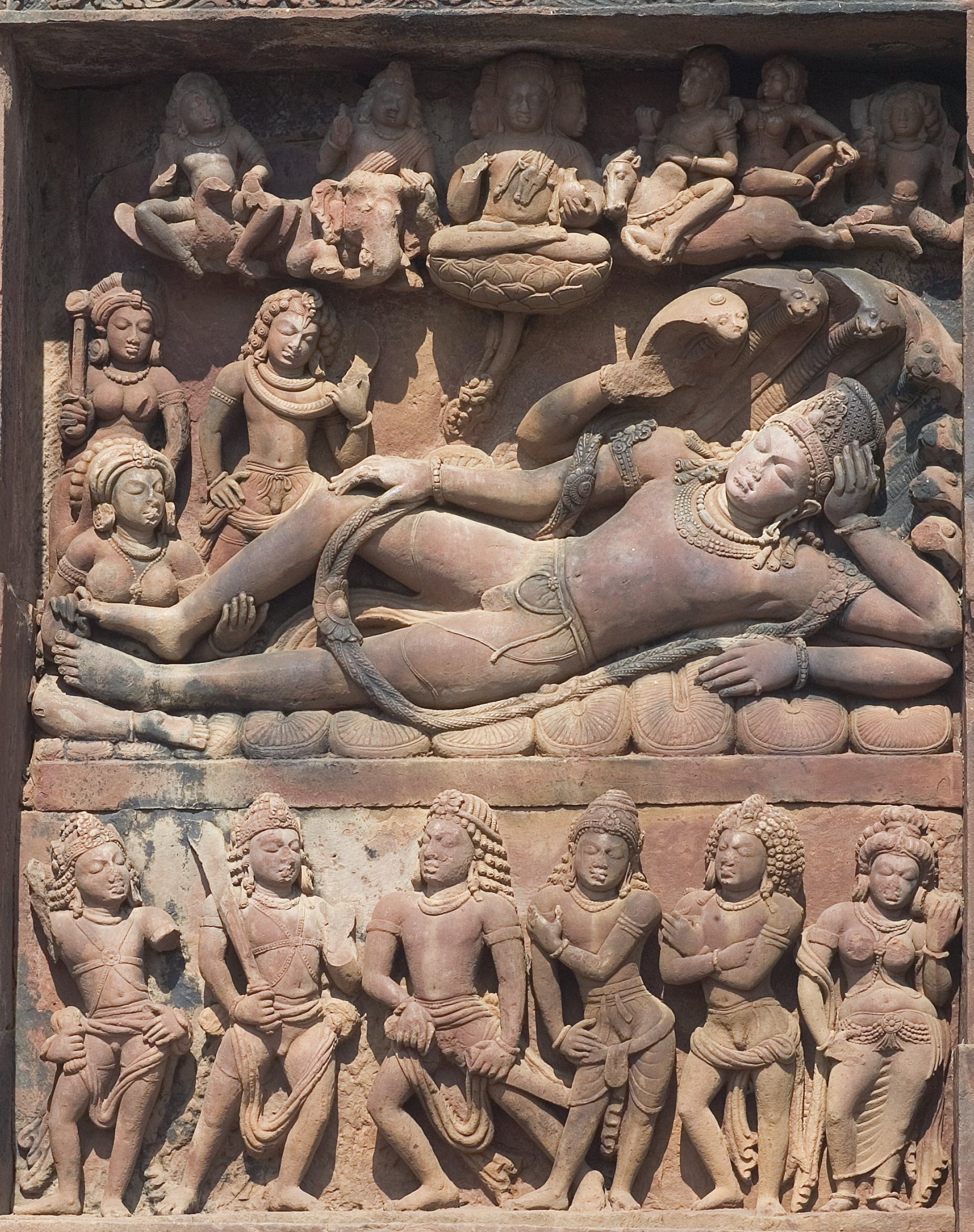
Vishnu asleep on the serpent Ananta:
Relief panel on the south facade of the Vishnu Temple
found in Deogarh, India
Chalyukya Dynasty
320 - 647 CE
Your eBook, Kleiner Art Through the Ages, 15th edition, describes the image as follows. "On the south, Vishnu sleeps on the coils of the giant serpent Ananta, whose multiple heads form a kind of umbrella around the god’s face. While Lakshmi massages her husband’s legs (he has cramps as he gives birth), the four-armed Vishnu dreams the universe into reality. A lotus plant (said to have grown out of Vishnu’s navel) supports the four-headed Hindu god of creation, Brahma. Flanking him are other important Hindu divinities, including Shiva on his bull. Below are six figures. The four at the right are personifications of Vishnu’s various powers. They will defeat the two armed demons at the left. The sculptor carved all the figures in the classic Gupta style, with smooth bodies and clinging garments"
This high relief sculptural panel is one of three that decorate the façades of a small temple to Vishnu, another important
male god of Hinduism.
Dashavatar Temple (Gupta-period)
The temple itself is an early example of the northern-style of Hindu temple: a cella (image room) topped by a tall
tower “organic” tower (sikhara).
Form
Approximately life-size figure; a high relief, sculptured narrative scene with many figures, composed to depict the Hindu deity, Vishnu, in one of his most iconic roles assisting in the creation of the universe.
Style
Gupta Style.
Meaning
Iconography – Vishnu has many incarnations (avatars); the god takes on different forms as needed to achieve miraculous salvations of humanity, in his role as the preserver of the universe. Hindu mythological cosmology includes the concept of enormous cycles of time during which the universe is created, destroyed, and re-created, again and again. The narrative scene, which shows very little “action,” nevertheless, depicts the beginning of a universe being created out of an empty void. Vishnu sleeps comfortably on the back of the divine multi-headed serpent, Ananta, who shields him with his hoods; Vishnu cushions his head with one of his four arms (symbols of supernatural power), while his dutiful wife, Lakshmi, herself a powerful Hindu goddess, massages his feet. Out of Vishnu’s navel grows a lotus plant, as he dreams the universe into being; at the top of long stem rises an open lotus flower upon which sits the Hindu deity Brahma, flanked by Shiva and other deities riding on their animal steeds. The scene at the base of the relief depicts a separate story.
Context
Flourishing Hinduism and Hindu art in India in the Gupta period.
Vishvanathan Temple (elevation and ground plan)
Vishvanathan Temple: (looking north)
Ground Plan: plan of the Vishvanatha Temple
Mithuna Reliefs: detail of the north side of the Vishvanatha Temple
found in Khajuraho, India
Chandella Dynasty
647 - 1200 CE
Your eBook, Kleiner Art Through the Ages, 15th edition, describes the image as follows. "The reliefs of Thanjavur’s Rajarajeshvara Temple are typical of southern temple decoration, which is generally limited to images of deities. The exterior walls of Khajuraho’s Vishvanatha Temple are equally typical of northern temples in the profusion of sculptures depicting mortals as well as gods, especially pairs of men and women (mithunas) embracing or engaged in sexual intercourse in an extraordinary range of positions."
An excellent example of the mature form on the northern-style Hindu temple. See the ground plan, and the erotic sculptures that are common in Khajuraho at this time.
Form
Temple: The main form represents a mountain range in the Himalayas where the Hindu god Shiva is thought to dwell; the
high base is multiple stepped, decreasing in dimension as it rises; each tall tower is topped by a characteristic
amalaka shaped like a mushroom cap. The huge pile of stone has a tiny, dark, interior space for the deity
(
cella).
Sculpture: high relief carvings that appear three-dimensional to the viewer; life-size figures
of mortals and deities engage in sexual play in square compositions flanked by standing figures of female beauties
in various seductive poses.
Style
Architecture: Northern Style: the towers are “organic” slightly rounded in shape, resembling something that grows in
nature (like cactus) in an almost fractal proliferation of tower forms.
Sculpture: variant on the Gupta idealized
human body; Study Question: How would you characterize the Gupta Style, what qualities seem consistent
across the ages?
Meaning
The temple complex is dedicated to Shiva, as the Lord of the World (Vishvanatha). The architecture is a place of worship and veneration; unlike the Christian basilica, or the Islamic mosque, the space is not designed to hold a large congregation. The graphic depictions of sexual play are meant to symbolize or suggest the deeply intimate relationship that exists between the worshipper and the deity, here Shiva as the spiritual lover.
Context
Consistency of Indian Art over the centuries; religious ideals expressed in visual forms. Worship: Hindu artworks/images as foci of individual devotion, bhakti. The forms/images actually contain the spirit of the deity, as "living " forms, not just symbols.
Shiva as Nataraja
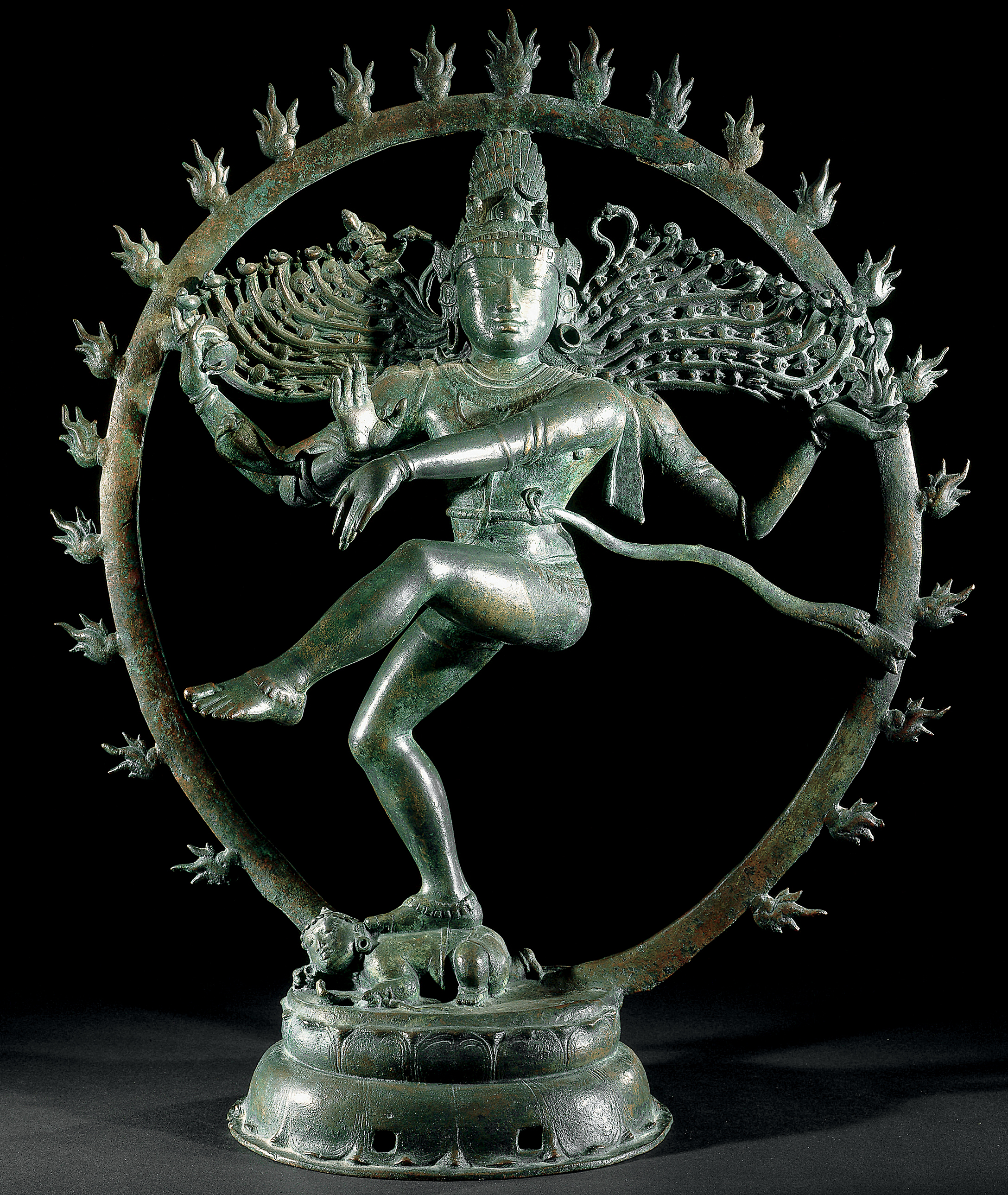
Shiva as Nataraja: solid-bronze statuette of Shiva as Lord of the Dance
found in Tamil Nadu, India
Chola Dynasty
647 - 1200 CE
Your eBook, Kleiner Art Through the Ages, 15th edition, describes the image as follows. "The statuette illustrated here comes from Tamil Nadu and recalls the sixth-century relief in the Badami cave representing the god Shiva. Cast in solid bronze around 1000, it is one of many examples of moveable images of deities created under the Chola kings and still used in Hindu rituals today. Here, Shiva dances as Nataraja (Lord of the Dance) by balancing on one leg atop Apasmara, the dwarf of ignorance, which the god stamps out as he dances. Shiva extends all four arms, two of them touching the flaming nimbus (“light of glory”) encircling him. These two upper hands also hold a small drum (right hand) and a flame (left hand). "
This sculpture is an excellent example of a group of small-mid-scale bronze images of Shiva as the Lord of the Dance, produced in South India during the Chola Dynasty c. 1100.
Form
3-dimensional, in-the-round figure, representing a form of Shiva standardized in this time and place. Multiple limbs representing superhuman powers. These images were meant to be portable and carried through the streets for seasonal festivals.
Style
A variant on the Gupta style; idealized forms of the human figure.
Meaning
Iconography – Hindu mythology: Shiva Nataraja represents Shiva in a blissful trance, dancing to the beat of a small drum that he holds in one of his proper right hands; in this guise he completes the cycle begun by Vishnu’s dream, and initiates the destruction of the universe, a philosophical given and necessity in Hinduism. Beneath his supporting right foot he steps on a small demonic figure that symbolizes ignorance; his matted locks fly out in fan-shaped arcs behind his head as he moves to the rhythms of the drumbeat; sometimes a small female figure sits within those locks – she is the goddess, Ganga, of the Ganges River, whose mythological fall from heaven was softened by the cushion of Shiva’s matted locks. In Shiva’s proper left hand is the flame he uses to ignite the conflagration, symbolized the circle of fire that surrounds the figure, that will bring the cycle of time to its end. His left arm and leg, in the elegant posture of Indian dance, point to moksha, or release (nirvana, in Buddhism).
Context
Borobudur
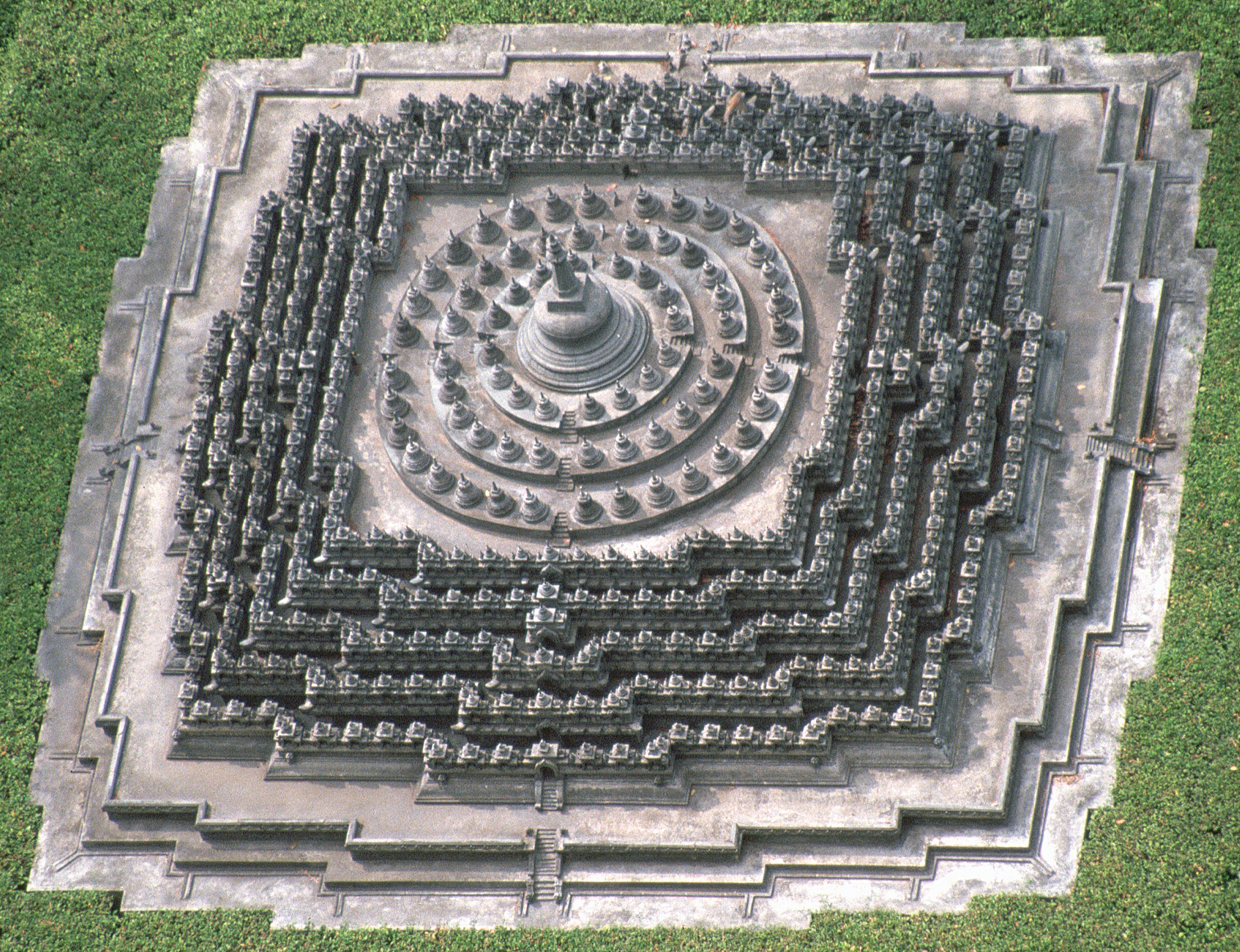
Borobudur: gigantic unique Buddhist monument
found in Java, Indonesia
Shailendra Dynasty
647 - 1200 CE
Your eBook, Kleiner Art Through the Ages, 15th edition, describes the image as follows. "Unique in both form and meaning, Borobudur is a Buddhist monument of colossal size, measuring about 400 feet per side at the base and about 98 feet tall. Built over a small hill on nine terraces accessed by four stairways aligned with the cardinal compass points, the structure contains literally millions of blocks of volcanic stone. Visitors ascending the massive monument on their way to the summit encounter more than 500 life-size Buddha images, at least 1,000 relief panels, and some 1,500 stupas of various sizes. "
This is a unique type of Buddhist monument found only in Java: a stupa/cosmic, world mountain, center of the universe.
Built, It is one of the most famous religious monuments in the world.
Borobudur: Pathway to Enlightenment
Borobudur, Indonesia in 4K (Ultra HD)
Form
Essentially it is an elaborate stupa, like the Great Stupa at Sanchi. It is square, but the square base and terraces are further articulated by a repeating pattern of double diminishment toward the four corners. Between each level until the open circular area at the summit, are galleries open to the sky, which serve as routes for circumambulation (walking clockwise around the center). Along the way the walls of the galleries are embellished with elaborate low relief sculptural “programs’ that serve to illustrate the teachings of Buddhism. In the niches that top the walls of the galleries, large sculptures of the seated Buddha look out in all directions. On circular platforms at the summit 72 openwork stupas hold life-size figures of the seated Buddha; the huge stupa at the summit is closed, perhaps to symbolize the formlessness of Enlightenment and Nirvana, the ultimate goal of all Buddhist.
Style
The style of architecture and sculpture represent a local Javanese variation on the Gupta styles of India. Elegant and reflective of Javanese sense of beauty.
Meaning
Essentially it is an elaborate stupa, like the Great Stupa at Sanchi. It is square, but the square base and terraces are further articulated by a repeating pattern of double diminishment toward the four corners. Between each level until the open circular area at the summit, are galleries open to the sky, which serve as routes for circumambulation (walking clockwise around the center). Along the way the walls of the galleries are embellished with elaborate low relief sculptural “programs’ that serve to illustrate the teachings of Buddhism. In the niches that top the walls of the galleries, large sculptures of the seated Buddha look out in all directions. On circular platforms at the summit 72 openwork stupas hold life-size figures of the seated Buddha; the huge stupa at the summit is closed, perhaps to symbolize the formlessness of Enlightenment and Nirvana, the ultimate goal of all Buddhist.
Context
The stupa stands on a high plain overlooking the countryside, like a mountain. It reveals a deep understanding of Buddhism and its construction, which necessitated the organization of hundreds of designers, engineers, masons, and sculptors, speaks to the wealth and power of the Shailendra rulers.
Angkor Wat
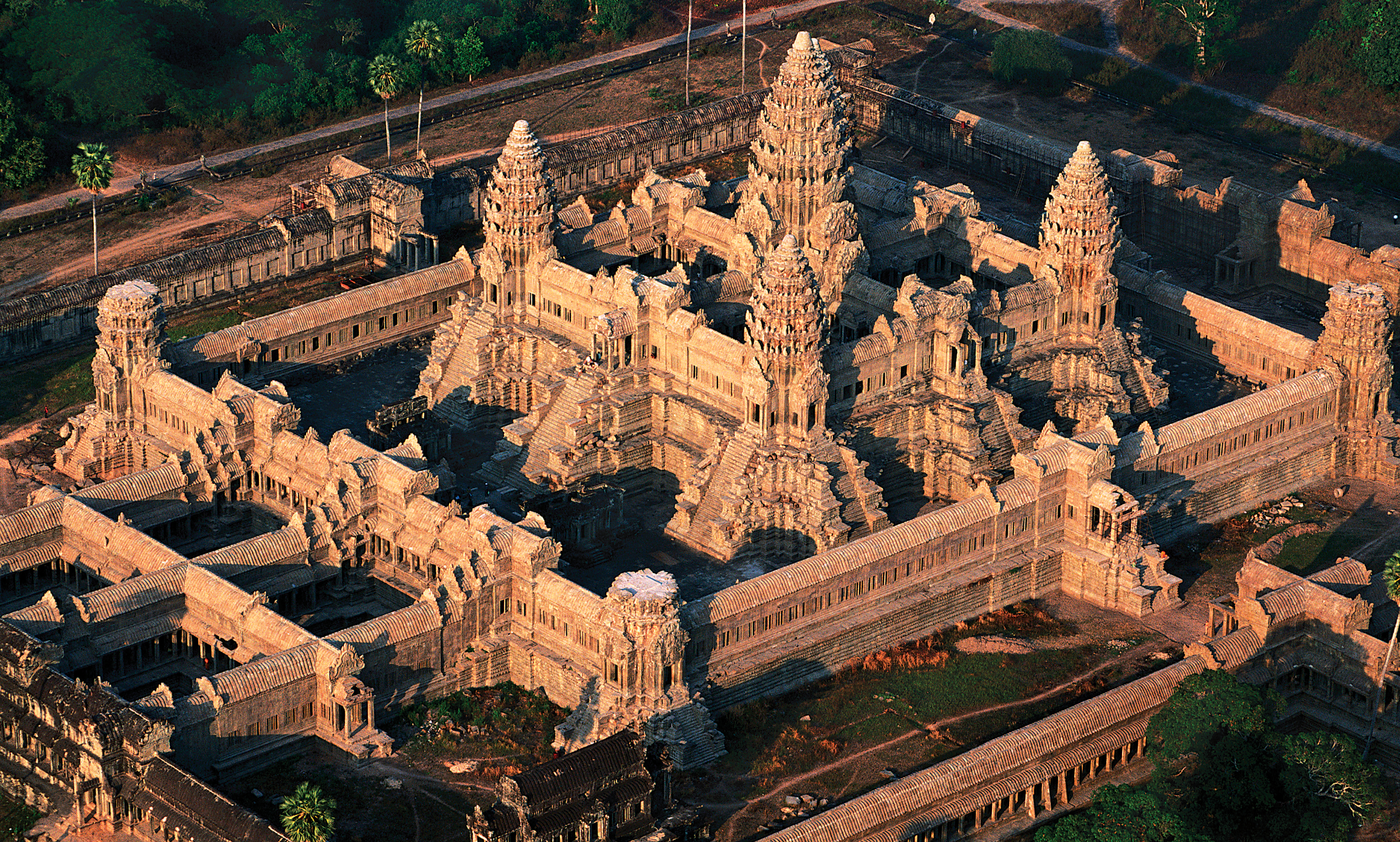
Angkor Wat: Angkor Wat has five towers symbolizing the five peaks of Mount Meru.
found in Angkor, Cambodia
Khmer Kingdom
647 - 1200 CE
Your eBook, Kleiner Art Through the Ages, 15th edition, describes the image as follows. "Of all the Khmer kings’ monuments, Angkor Wat is the most spectacular. Built by Suryavarman II (r. 1113–1150), it is the largest of the many Khmer temple complexes. Angkor Wat rises from a huge rectangle of land delineated by a moat measuring about 5,000 by 4,000 feet. Like the other Khmer temples, its purpose was to associate the king with his personal god, in this case Vishnu. "
Like Borobudur, Angkor Wat, is one of the most famous religious and art monuments in the world. It reflects Cambodian,
Khmer Dynasty ideas about divine kingship and Hindu mythology. It is also likely a 3-dimensional “representation”
of the myth of Vishnu churning the sea of milk to extract the nectar of immortality for the gods.
ANGKOR: LAND OF THE GODS: A Digital Reconstruction of Angkor Wat
Form
A distant variation of the Indian Northern Style Hindu Temple (platforms and sikharas) demonstrating how far Indian cultural and stylistic influence reached into southeast Asia. It is a symmetrically organized system of buildings linked by long, covered galleries. The area covered is over 400 acres.
Style
Based on Indian architectural forms
Meaning
The structure serves several purposes: temple to the Hindu God Vishnu, ruler’s palace, and possibly funerary temple for King Suryavarman II, who started the building.
Context
Like Borobudur, Angkor Wat was an enormous undertaking and engineering feat that required technological knowhow of great magnitude involving the moving of stone and water. The temple/mausoleum is also a political statement. Angkor, the city and Khmer capital was home to several monuments on the scale and magnitude of Angkor Wat.
King Suryavarman II holding court
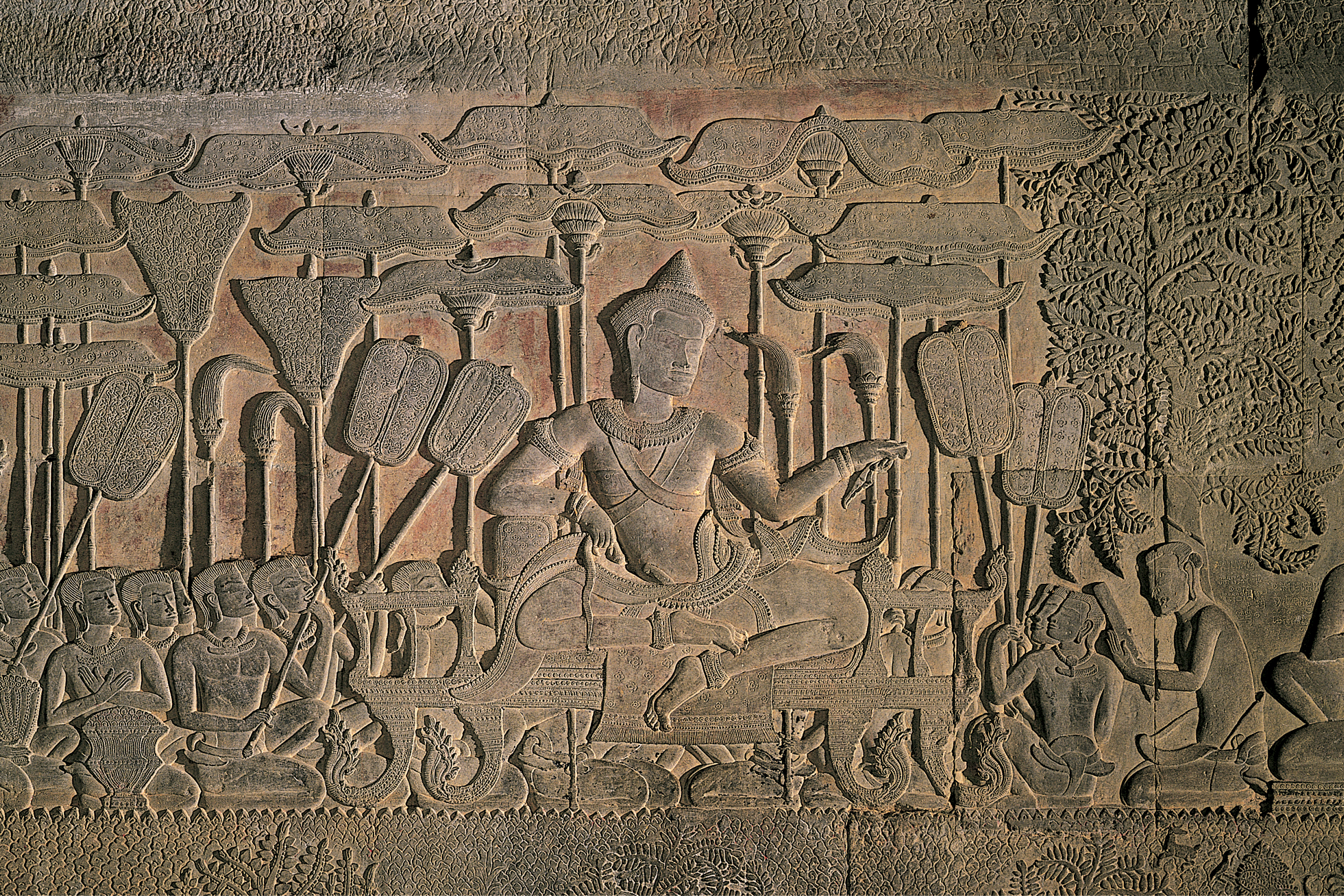
King Suryavarman II holding court: detail of a stone relief in the lowest gallery on the south side of Angkor Wat
found in Angkor Wat, Cambodia
Khmer Kingdom
647 - 1200 CE
Your eBook, Kleiner Art Through the Ages, 15th edition, describes the image as follows. "A relief on the inner wall of the lowest gallery shows the king holding court. Suryavarman II sits on an elaborate wooden throne, its bronze legs rising as cobra heads. Kneeling retainers, smaller than the king because they are lesser figures in the Khmer hierarchy, hold a forest of umbrellas and fans, emblems of Suryavarman’s exalted rank. "
Angkor (Land of the gods) : The Longest Bas Relief in the World
Form
Continuous, 12,900 square-feet, low relief carving.
Style
Based on Indian art forms; originality appears in the low relief (bas-relief) sculptural frieze on the inner walls of the outermost gallery; a distant variant of the Indian, Gupta style.
Meaning
The frieze tells stories from Hindu mythology, battle scenes from the ancient Hindu poetic epic, the Mahabharata, scenes from the royal life of King Suryavarman II, including a large “portrait;” and scenes from Hindu mythology connected to Vishnu, like the myth of Vishnu churning the sea of milk to extract the nectar of immortality for the gods.
Context
From chapter 32.
Krishna and Radha in a Pavilion

Krishna and Radha in a Pavilion: opaque watercolor on paper, 11 ⅛" x 7 ¾ "
found in Sanchi, India
Rajput Court
1526 - 1877 CE
Your eBook, Kleiner Art Through the Ages, 15th edition, describes the image as follows. "In the Krishna and Radha miniature, the lovers sit naked on a bed beneath a jeweled pavilion in a lush garden of ripe mangoes and flowering shrubs. Krishna gently touches Radha’s breast while looking directly into her face. Radha shyly averts her gaze. It is night, the time of lovemaking, and the dark monsoon sky momentarily lights up with a lightning flash indicating the moment’s electric passion. Lightning is one of the standard symbols used in Rajput and Pahari miniatures to represent sexual excitement. "
An example of native Indian art styles produced by artists of the Rajput courts, when India was ruled by the Islamic Mughal Empire.
Form
Small scale, album-size painting.
Style
“Indian” –idealized human figure style, a later variant on styles developed in Gupta India, and transmitted across time, practically unchanged for hundreds of years.
Meaning
Krishna (an avatar of Vishnu), known as the god of Love, engages his favorite beauty, Rhada, in love play. Iconography
of Krishna: “the dark one” he is a cowboy who spends his time tending the cows and flirting with the cowgirls; he
is a talented musician and dancer, and also capable of supernatural feats, such as vanquishing and reforming the evil
naga, Kaliya by dancing him to submission. As a child, to a human mother, he was mischievous, always stealing
balls of butter, and other pranks. He is lovable at any age.
Krishna - Hindu Deity
Krishna - A Most Beautiful Song... Wonderful Composition on Lord Krishna
Context
The Rajput courts were ruled by powerful native, Hindu families. Although subject to the Mughals, they continued to worship their traditional Hindu gods and patronize Hindu art, which featured mythological subjects such as Krishna and Radha.
Walking Buddha

Walking Buddha: bronze, seven feet two inches high
found in Bangkok, Thailand
Sukhothai Period
1206 - 1526 CE
Your eBook, Kleiner Art Through the Ages, 15th edition, describes the image as follows. "Sukhothai’s crowning artistic achievement was the development of a type of walking-Buddha statue displaying a distinctively Thai approach to body form. The bronze Buddha has broad shoulders and a narrow waist and wears a clinging monk’s robe. He strides forward, his right heel off the ground and his left arm raised with the hand held in the do-not-fear mudra (gesture) that encourages worshipers to come forward in reverence (see “ Buddhist Iconography ”). A flame leaps from the top of the Buddha’s head, and a sharp nose projects from his rounded face. The right arm hangs loosely, seemingly without muscles or joints, and resembles an elephant’s trunk. "
An original adaptation of the iconography of the standing Buddha image by Thai sculptors.
Form
Based on the Indian system of Buddhist representation of the standing figure of the Buddha: 3-dimensional, in the round, over-life-size sculpture. New: the Buddha actually striding forward with weight on left leg and right heel leaving the ground. Large flame-like form emerging from the ushnisha.
Style
A further adaption of the Indian Gupta Style: swelling shoulders and thighs, the right arm an elegant (irrational), curve.
Meaning
Traditional mudra: do not fear with left hand; striding forward suggests intimate presence. What else?
Symbolism of The Sukhothai Walking Buddha
Context
The city of Sukhothai (north, central Thailand) was the capital of the power Thai Kingdom by the same name, which controlled most of present-day Thailand (once known as Siam). Today the old capital is a UNESCO World Heritage Park. Under the Sukhothai Kingdom, replaced Mahayana ("the great vehicle ") Buddhism with Theravada (hinayana - "the small vehicle ") Buddhism, imported from Sri Lanka (Ceylon), which was made the official state religion. The Thai King was considered the patron and protector of Buddhism.

